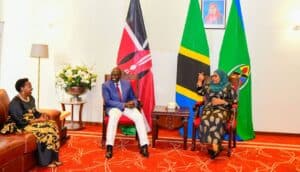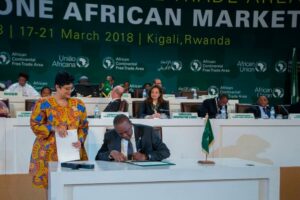
Continued Sabotage between East Africa’s two major states: A pretext for a blurred future of economic integration?
Sibling Squabbles
Whenever we hear talks of trade wars between China and the USA, it always sounds normal – two of the World’s largest economies fighting it out for global dominance. When the same is said of developing countries, questions arise, ranging from the logic behind it to the economic viability and welfare of the public. Since their independence, Tanzania and Kenya have remained the siblings who refused to live up to their potential. Of all the members of the East African Community, both old and new, Tanzania and Kenya are the biggest economies with $77 billion and $115 billion in GDP, respectively. The two states might as well hold the key to an East African integrated cross-border trade if they establish a sustainable relationship. Despite their economic potential, Kenya and Tanzania account for more diplomatic and trade squabbles of all states in the short history of the East African regional integration. If the East African Community is to survive the economic storms ahead, its two largest economies must first chat their way out of their history of economic and diplomatic sabotage.
Never a Sister’s keeper, 1st Phase of the EAC
The early years after independence saw a healthy, optimistic approach to relations between Kenya and Tanzania. East Africa had a dream that seemed viable given their close social and geographical proximity. However, at all levels of proximity, Tanzania and Kenya account for most of the factors that might have accelerated the much-needed political union for such young, poor, and vulnerable states. Barely ten years after its official establishment, the EAC was dissolved owing to many economic and diplomatic challenges.
The scuffles between the two sister states date back to as early as 1977 when Tanzania closed its borders with Kenya. The closure was a direct attack on trade and the then-active East African Common Market. Tanzania further blamed Kenya for failing to commit funds as agreed for the EAC budget in 1977 and allegedly dismantling the East African Airways Corporation. Moreover, between the two nations, an inevitable conflict of ideologies has never been erased to this day. Tanzanian socialists always see capitalist Kenyans as a people hellbent on taking advantage of all trade and resource opportunities.
The early years of optimism were buried under the hatred manufactured by ideologies, unhealthy competition, and petty misunderstandings. Although Idd Amin’s coup in Uganda and its role in weakening the fraternity can’t be dismissed, two major states of the community clearly failed to live up to expectations. A common understanding between Tanzania and Kenya might have steered Uganda in the right direction. Both states failed, and the first version of the EAC fell with them.
Trade Wars, the 2nd Phase of the EAC
The collapse of the first EAC was followed by a few conflicts, most notably the Tanzania-Uganda war leading to the eventual ousting of General Idd Amin Dada of Uganda. Seemingly, the high-tempered dictator had brought Kenya and Tanzania a bit closer again. Subsequent decades would see a more tranquil relationship as both countries changed leadership over multiple phased transitions. One wound that never really healed was a lack of trust in trade. Cautious approaches embedded in each other’s ideological history would continue for much longer – arguably, to this date.
The first five years of John Magufuli’s presidency in Tanzania saw a socialist-esque style of leadership and diplomacy. Tanzania was taken back to unhealthy competition, quarrels, and diplomatic rows of the past. In 2017, over 6,000 one-day-old chicks bound for Tanzania were burnt alive on the border for allegations of smuggling and possible flu infection. Earlier the same year, Tanzania had approved auctioning 1300 cows caught grazing on the Tanzania side of the common border. A few weeks later, it was reported that Kenya had confiscated about 4,000 cows from Tanzania in what looked like reciprocity. The two countries with a key to East Africa’s prosperity were at war again, albeit a cold one.
Tanzania President Samia Suluhu (R) speaks to Kenya’s President William Ruto (C) and Kenya’s First Lady Rachel Ruto in Dar es Salaam, Tanzania, on October 10. /State House Kenya handout
In 2020, when COVID-19 was at its peak, Tanzania closed its border with Kenya in retaliation for Kenya’s safety measures against Tanzanians. Given that Tanzania had denied the reported seriousness of the pandemic, it had refused to take any measures. Kenya saw a danger for her people and restricted border crossing without mandatory testing. In retaliation, Tanzania’s John Magufuli declared a complete closure of the border to people and cargo, further limiting the already poor COVID-19 trade environment. It would oblige the then-President of Kenya, Uhuru Kenyatta, to fly to Tanzania for talks with President Magufuli.
The latest trade wars have been mainly on maize, one of Tanzania’s major exports to Kenya. New regulations requiring traders to open offices in Tanzania and register with Brela (the licensing authority) added fuel to the legendary animosity between the two siblings. Kenya saw the regulations as going against the East African common market protocol and urged a change to accommodate free trade agreements in the region.
Continued conflicts in trade agreements between Tanzania and Kenya will always limit regional potential. Two giants of the block disagreeing on almost everything is a sign of doom. Fair and healthy competition in trade is a welcome sight between neighboring countries. Instead of emulating cold rivalries of South and North Korea, India and Pakistan, or Russia and Ukraine, why not try the US-Canada sisterhood?
What the Future Holds for EAC’s Top Economies
The introduction of more countries into the EAC fold has added the much-needed versatility that was lacking in a three-horse race in the 1960s and 70s. However, the power of the two Swahili-speaking countries remains significant in swinging the union in whatever direction they may want. If Tanzania and Kenya can establish a freer architecture for trade, movement, and integration, the rest of the EAC member states can easily follow.
Unlike any other duos in the EAC, Tanzania and Kenya enjoy social and linguistic unity that makes it easy to interact. Both use Kiswahili as their national language and can fit seamlessly into one another’s social systems, bar a few traits from their varied ideological backgrounds. Freedom of movement, free trade, and a relaxed diplomatic posture could see the two states amass remarkable economic benefits.
For a long time before the integration of the DRC, the two East African giants had the largest human capital and a combined population of over 110 million people, as per the latest censuses in both states. These numbers indicate a huge market potential for businesses if allowed to exploit it. According to the Human Capital Index report of 2020, Kenya’s human capital quality average is higher than all of the Sub-Saharan region and lower middle income countries. Using this quality for shared benefit is a logical approach to greater economic growth.
Economic sabotage does not benefit anyone. Instead of holding each other back in a brinkmanship style, Kenya and Tanzania should work together to ensure free trade and ease of border crossing. They should ease tax burdens on the traders, remove tariff barriers, and ease mobility restrictions. A freer, robust economic partnership between Kenya and Tanzania is the master key for a prosperous East African block.




